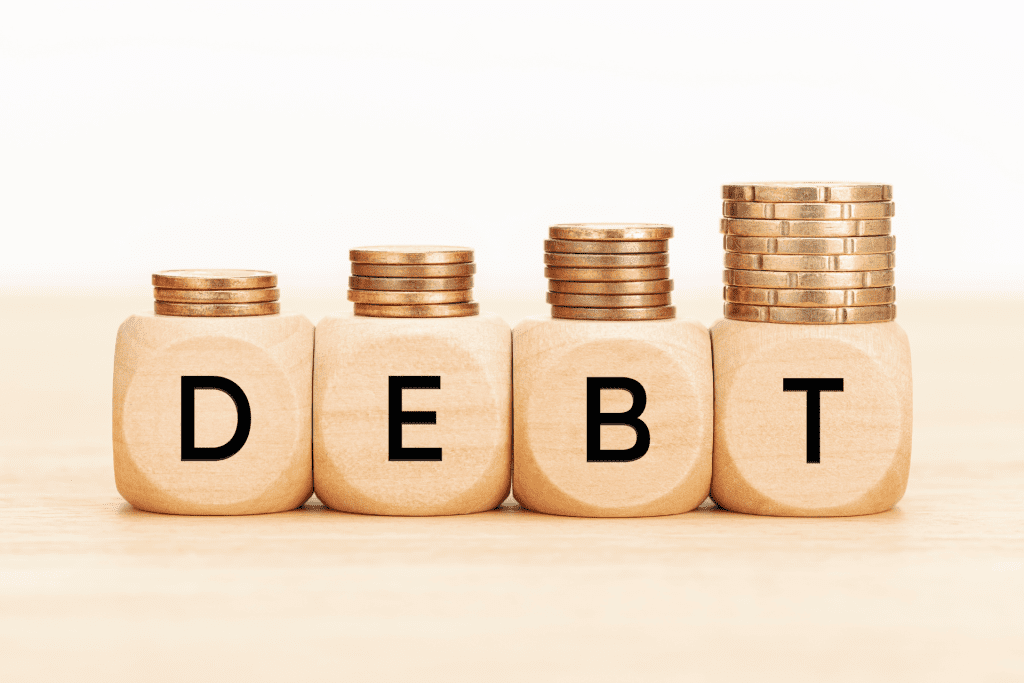
Debt often wears a dark cloak in our financial narratives, casting a shadow of apprehension. But what if we told you that not all debt is created equal? In the financial realm, there’s a crucial distinction between “good debt” and “bad debt.” The simple truth is that bad debt costs money, while good debt makes money.
At Cashflow Properties, we’ve come to recognise debt, good or bad, as the norm in almost every household. Whether it’s credit cards, student loans, or mortgages, debt is a financial reality.
The RBA indicates that Australians currently face a record-high household debt-to-disposable income ratio of 188.5% during periods of rising rates. This is a significant increase from 2012, where the ratio stood at 162.0%, and 2002, when it was at 130.2%. Understanding the dynamics of good and bad debt has never been more crucial considering these escalating figures.
In this blog, we cut through the complexity to give you a clear understanding of good debt versus bad debt and provide key insights on how strategic property investment in Sydney can be a game-changer in building wealth.
Good Debt vs. Bad Debt — Understanding the Basics

Imagine bad debt as a tricky path with credit cards, personal loans, and car loans waiting to trip you up. They’re like those sneaky expenses that eat away at your money. High interest rates on credit cards, complicated personal loans, and car loans that sound cool but might not be the smartest money move – that’s the bad debt gang.
Of course, that doesn’t mean you should beat yourself up over a previous financial decision. In many cases, Australians may have acquired these types of debts out of necessity. For instance, needing to apply for a car loan so they can buy a new or used car to help them get from A to B or taking out a credit card to help cover an unexpected home repair or vet bill.
Now, on the sunny side, we have good debt. Think of it like a well-lit road leading to something valuable – property. Mortgage debt is the star player here. Mortgage debt can be considered good debt when used to acquire appreciating assets such as real estate. The key differentiator here is that the investment has the potential to grow in value over time, offsetting the cost of the debt.
An easy way to differentiate between the two types of debt is: good debt helps me build wealth for the future, but bad debt is the result of a previous financial decision eating away at my budget in the present.
Now that we understand the difference between “good” and “bad” debt, let’s explore the idea of property investing in Sydney in better detail.
The Evolution of Mortgage Debt: Rising Asset Values and Relevance
Historically, mortgage debt was the hero – you buy a house, or begin property investing in Sydney, its value rises, and your debt becomes smaller compared to what your property is worth. But surprise! In Australia’s ever-changing property market, this narrative encounters a twist. The relentless rise in asset values, while a boon for property owners, poses questions about the perpetual relevance of mortgage debt as a ‘good’ financial instrument.
According to Real Estate Investar, Sydney property investing has taken a dramatic turn in terms of price, experiencing a 0.55% change within the last year with the average unit clocking in at an average of $900,000.
As property values soar, the percentage of the property’s value covered by the mortgage decreases. This diminishing debt-to-equity ratio traditionally signalled financial prudence. However, the question arises: Does the escalating value of assets make mortgage debt less crucial in the wealth-building equation? Let’s find out!
Taking Calculate Risk with Good Debt during Property Acquisition

Despite the changing dynamics, embracing good debt, especially during the acquisition stage of property, can be a calculated risk worth taking. This is the phase where strategic property investment in Sydney comes into play.
Smart investors, like our founder at Cashflow Properties, Bharat Patel, who understand the nuances of the market, are willing to take a gamble with good debt during the property-buying phase. Strategically playing it like a game of chess, using mortgage debt in areas where properties are likely to grow in value. Risky? Yes. Rewarding? Potentially, big time!
The rationale behind this approach is to capitalise on the anticipated increase in property values. By strategically choosing properties in growth corridors, investors can potentially outpace the growth of their debt, creating equity and building wealth over time. This calculated risk, when undertaken with thorough research and a long-term vision, positions good debt as a powerful wealth-building tool.
Tackling Inflation —Dealbreaker or Not?
The key to achieving financial freedom is getting your investments right during an ongoing inflation. In Australia, where the cost of living is rising, this is your secret weapon. Property values usually go up faster than inflation, accelerating the value of your assets upwards. This becomes particularly advantageous for individuals with a well-curated property portfolio, enabling them to create a robust financial future.
Bharat Patel’s case study exemplifies how a strategic approach to property investment in Sydney, coupled with the right use of debt, can position an investor to ride the wave of inflation. By constantly reassessing the portfolio, making informed decisions, and leveraging market trends, Patel has set himself on a trajectory toward becoming a millionaire through the strategic appreciation of his property assets.
Getting it Right — Making Informed Decisions for Financial Success
In conclusion, strategic property investment in Sydney hinges on a detailed understanding of good and bad debt. Our exploration into the financial interplay reveals that during property acquisition, leveraging good debt is a calculated risk that can be rewarding.
In the face of rising property values and inflation, investors like Bharat Patel exemplify the power of strategic debt use. Patel’s success underscores the importance of navigating market dynamics and viewing good debt as a crucial wealth-building tool.
In the financial landscape, Patel’s approach becomes a practical guide — emphasising that strategic property investment, coupled with savvy debt management, can weather economic shifts and pave the way toward significant wealth accumulation.
As you navigate financial decisions, let this analysis be your compass, steering you toward informed choices, calculated risks, and the potential for lasting wealth through strategic property investments.
Your Sydney property investing journey begins with Cashflow Properties
Whether you’re looking to build wealth over time or secure immediate cash flow, understanding the role of debt is crucial. At Cashflow Properties, we are devoted to guiding our investors to utilise good debt strategically to leverage investment opportunities in the real estate market.
Cashflow Properties takes a unique approach to property investing in Sydney. We employ a 6-step procedure that covers everything involved in purchasing a property, from risk assessment to tapping into our network of buyer’s agents, organising inspections and settlement. Learn more about our property investment services by contacting us today.

